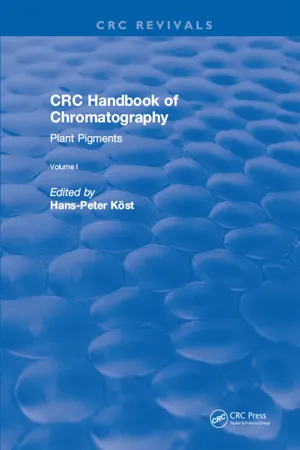
eBook - ePub
Revival: CRC Handbook of Chromatography (1988)
Volume I: Plant Pigments
Hans-Peter Kost
This is a test
- 344 páginas
- English
- ePUB (apto para móviles)
- Disponible en iOS y Android
eBook - ePub
Revival: CRC Handbook of Chromatography (1988)
Volume I: Plant Pigments
Hans-Peter Kost
Detalles del libro
Vista previa del libro
Índice
Citas
Información del libro
The CRC Handbook of Chromatography is a series of work-bench references for scientists and researchers using chromatographic systems for the analysis of organic and inorganic compounds.This handbook is an assemblage of tables where, besides data obtained by modern separation methods, older sources often difficult to access have been included to give maximum information. For use in scientific research and routine analysis where the exact determination of plant pigments, because of their light absorbing properties and defined tasks, is necessary.
Preguntas frecuentes
¿Cómo cancelo mi suscripción?
¿Cómo descargo los libros?
Por el momento, todos nuestros libros ePub adaptables a dispositivos móviles se pueden descargar a través de la aplicación. La mayor parte de nuestros PDF también se puede descargar y ya estamos trabajando para que el resto también sea descargable. Obtén más información aquí.
¿En qué se diferencian los planes de precios?
Ambos planes te permiten acceder por completo a la biblioteca y a todas las funciones de Perlego. Las únicas diferencias son el precio y el período de suscripción: con el plan anual ahorrarás en torno a un 30 % en comparación con 12 meses de un plan mensual.
¿Qué es Perlego?
Somos un servicio de suscripción de libros de texto en línea que te permite acceder a toda una biblioteca en línea por menos de lo que cuesta un libro al mes. Con más de un millón de libros sobre más de 1000 categorías, ¡tenemos todo lo que necesitas! Obtén más información aquí.
¿Perlego ofrece la función de texto a voz?
Busca el símbolo de lectura en voz alta en tu próximo libro para ver si puedes escucharlo. La herramienta de lectura en voz alta lee el texto en voz alta por ti, resaltando el texto a medida que se lee. Puedes pausarla, acelerarla y ralentizarla. Obtén más información aquí.
¿Es Revival: CRC Handbook of Chromatography (1988) un PDF/ePUB en línea?
Sí, puedes acceder a Revival: CRC Handbook of Chromatography (1988) de Hans-Peter Kost en formato PDF o ePUB, así como a otros libros populares de Naturwissenschaften y Industrielle & technische Chemie. Tenemos más de un millón de libros disponibles en nuestro catálogo para que explores.
Información
Part I: Carotenoids
Chromatographic Methods for the Separation of Carotenoids
INTRODUCTION
Many of the vividly red, orange, or yellow flowers and fruits, as well as a number of animals, owe their appearance to the presence of a class of more-or-less unsaturated tetra-terpenoids called “carotenoids”.1 The name comes from the carrot, Daucus carota, from which the prechromatographic “carotene” was isolated (Wackenroder, 1831); only by chromatography could it be shown that there are α-, β-, γ-, and δ-carotenes in the carrot.1, 2, 3
Since then, the carotenoids have been extensively studied in many branches of natural science.1,3, 4, 5 The greater lability of the chlorophylls during autumnal necrosis reveals the carotenoids in the “fall colors” of deciduous trees. Carotenoids are present in the thylakoid membranes of higher plants, algae, and photosynthetic bacteria; here one part of their function is to serve with lesser or greater efficiency as accessory pigments for light-harvesting in photosynthesis. They are not confined to the photosynthetic organelles; however, their presence and synthesis in so many fungi, yeasts, and bacteria which sometimes exhibit intense colors suggest another, wider function: the universal function of carotenoids as photoprotectants (compare References 3, 4, 5, 7, 8, 9).
Carotenoids are also contained in the display apparatus of a variety of flowers;10,11 here they help to attract insects. Many animals contain carotenoids, also, but only via their diet, for they cannot synthesize them as plants can. Chemically, carotenoids are hydrocarbons with numerous conjugated double bonds. The first carotenoid whose structure was elucidated (by Karrer in 1930) was lycopene, the red pigment of tomatoes and other fruits (for historic background, see References 1 and 12).
SOME REMARKS ON CAROTENOID FORMATION AND SOURCES3, 4, 5,7, 8, 9, 10,13, 14, 15
The first “typical” intermediate in carotenoid biosynthesis is isopentenyldiphosphate, which is formed via hydroxymethylglutaryl CoA and then mevalonic acid from the condensation of three molecules of acetyl CoA which arise from the intermediary metabolism of carbohydrates and lipids. By the action of an isomerase, isopentenyldiphosphate is converted to dimethylallyldiphosphate, which easily splits off a diphosphate anion while leaving a carbonium ion. The carbonium ion may now condense head-to-tail with one molecule of isopentenyldiphosphate to form geranyldiphosphate. By the addition of a further molecule of isopentenyldiphosphate, farnesyldiphosphate, a C-15 intermediate, is synthesized. After their formation from this compound, two tetraisoprenoid geranyl-geranyldiphosphates are condensed to molecules of the phytoene, a colorless compound which contains only three conjugated double bonds.
Via stepwise dehydrogenation, phytoene is converted to phytofluene, ζ-carotene, and neurosporene. Eventually, the intensely red-colored lycopene is formed. Lycopene may be converted via ring formation — the α- or β-ionone rings of α- or β-carotene, respectively.
Animal pigments may have undergone considerable modifications; an exampl...
Índice
- Cover
- Title Page
- Copyright Page
- Table of Contents
- Part I: CAROTENOIDS
- PART II: PORPHYRINS (EXCLUSIVE OF CHLOROPHYLLS)
- PART III: CHLOROPHYLLS
- INDEX
Estilos de citas para Revival: CRC Handbook of Chromatography (1988)
APA 6 Citation
Kost, H.-P. (2019). CRC Handbook of Chromatography (1st ed.). CRC Press. Retrieved from https://www.perlego.com/book/1501238/crc-handbook-of-chromatography-volume-i-plant-pigments-pdf (Original work published 2019)
Chicago Citation
Kost, Hans-Peter. (2019) 2019. CRC Handbook of Chromatography. 1st ed. CRC Press. https://www.perlego.com/book/1501238/crc-handbook-of-chromatography-volume-i-plant-pigments-pdf.
Harvard Citation
Kost, H.-P. (2019) CRC Handbook of Chromatography. 1st edn. CRC Press. Available at: https://www.perlego.com/book/1501238/crc-handbook-of-chromatography-volume-i-plant-pigments-pdf (Accessed: 14 October 2022).
MLA 7 Citation
Kost, Hans-Peter. CRC Handbook of Chromatography. 1st ed. CRC Press, 2019. Web. 14 Oct. 2022.